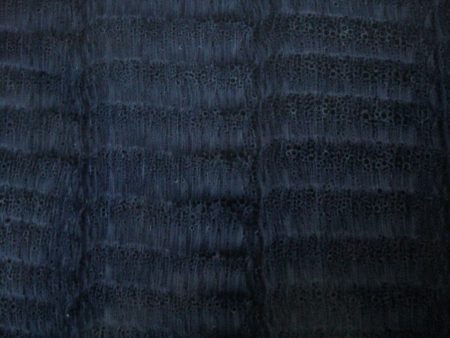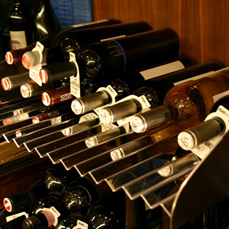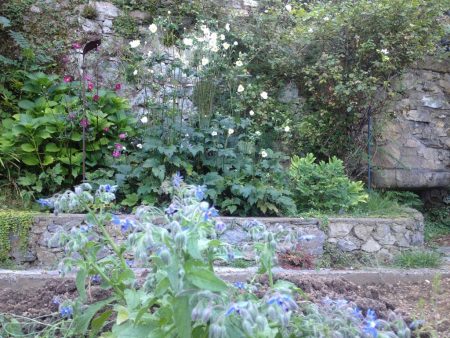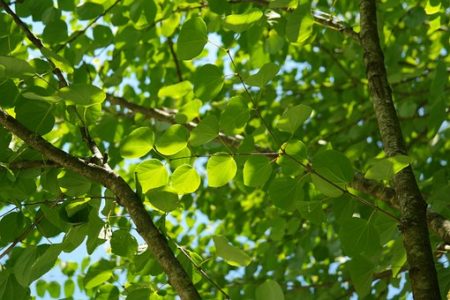Skip to content
My own garden has been evolving continuously since 1977. The first step was to repair and extend the natural stone walls, partly draped in ivy (Hedera helix). Then began the great challenge of creating support structures based on the existing framework. A striking space with old large-leaved lime trees (Tilia platyphyllos), which give the house its name, as well as the historic “kitchen garden” and an existing fluid system of pathways in the south-facing garden formed the basis for the design concept.
The interplay between a shady garden north of the house and a garden to the south was an appealing aspect and clearly full of potential.
The kitchen garden was in a state of neglect. A fence was used to redefine its boundaries. A found fountain bowl was integrated into a stone wall as an attractive accent, narrow box hedges were planted around vegetable patches, while the existing fire pond was converted into a swimming pool for the family. At the centre of the vegetable garden grows an enchantingly scented damask rose (Rosa trigintipetala).
As a central intersection of the existing gravel paths, as if standing on a balcony (overlooking the view from the garden?), the south garden facing the sun contains a huge catalpa tree (Catalpa bignonioides). Taking this as my starting-point, I added a few impressions that picked up on the theme of the sun: the ´Gloire de Dijon´ roses on the reed-grey wall of the house, ´Madame Hardy´ as a companion to a seating area against the house, as well as ´Buff Beauty´ at the entrance to the kitchen garden. As a counterpoint to the bright beauties, I built an old sandstone enclosure around the historic velvety dark-red fragrant rose, as yet unidentified, but known to the family as the Wolfram rose.
As a backdrop to the south I deliberately introduced plants to create the impression that the garden continued further. I set accents with a small number of pots and containers, whose plants contrasted with and softened the strict composition of the garden. The main entrance, whose gate is situated at the north-east corner of the house, was also accentuated with a frame of climbing hydrangea (Hydrangea petiolaris), its typical growth habit providing a canopy. The south-east corner was dominated by an ancient ivy “tree”, as can be seen in the main picture, whose impressive splendour leaves nothing to add.
Since a historic well existed in each garden area, and in the north garden even took the form of an ornamental fountain with a water feature, it was clear that these should be highlighted. In the kitchen garden this was done with magnificent hollyhocks (Alcea rosea), while the well to the north is today framed by ostrich ferns (Mateuccia struthhiopteris) that pick up on the shadowy depth of the surrounding giant trees. A sunny spot created by one of the giant trees falling down due to age gave me the opportunity to plant a katsura tree, also known as the caramel tree (Cercidiphyllum japonicum), one of my favourite species.
Other gardens: Schlosspark Hornegg, Planetary Garden Eggenberg, Mediterranean Garden, Woodlandgarden
Bei Tulpen bevorzuge ich die langstieligen, die in ihrer Eleganz unübertroffen sind. Tulipa Purissima ist ein solches Beispiel. Besonders schön sind ihre weißen Blütenblätter, die sich tief im Blütenkelch in einen Hauch von Gelb verfärben.

Abelonemuschel

Agame

Blauer Karakul

Die schönste aller Schwertlilien ist für mich die Dalmatinische, auch Bleiche Iris genannt. Im Vergleich zu ihren Artgenossinnen ist sie im Erscheinungsbild ihrer Blüten von vornehmer Zurückhaltung.
Ihr Blühend-Duftenden, wohin ist euer Duft entschwunden? Ich muss leider immer wieder die Erfahrung machen, dass Neupflanzungen mit altbekannten Duftpflanzen wie Reseda (Reseda odorata L.), Zyclamen (Cyclamen), Nachtviolen (Hesperis matronalis), Philadelphus, Seidelbast (Daphne mezereum), Flieder (Syringa), Ölweide (Elaeagnus commutata), Traubenkirsche (Prunus padus), Linden (Tilia) kaum mehr duften. Hingegen verströmen die Alteingesessenen einen betörenden Duft.

Die Elsbeere (Sorbus torminalis), als Heilpflanze nicht mehr bekannt und als Obstbaum verschmäht, ist in Vergessenheit geraten. Nur in der Most- und Branntweinherstellung hatte die Frucht stets Bedeutung, wie auch das Holz bei Instrumentenbauern immer beliebt war. Ihr Blatt ist unverwechselbar und erfreut durch atemberaubende Herbstverfärbung.

Verstellbares Flaschenregal mit Wellen-Boden aus rostfreiem Stahl.

Im Gemüsegarten sollten Gewürzpflanzen und Heilkräuter nicht fehlen. Für mich sollte es kein geschlossenes Kräutergärtlein sein; die Kräuter sollten als duftende wie dekorative Zwischenpflanzungen genutzt werden. Reizvoll sind vor allem jene Kräuter, die sich selbst aussäen. Das sind beispielsweise Bohnenkraut (Satureja) und Borretsch (Borago officinalis) – mein absoluter Liebling: Dieser wird nicht mehr als Heilpflanze genutzt sondern erfreut als Bienen- und Augenweide. Seine Blütenköpfchen, immer sittsam gesenkt, anmutig zurückhaltend. Im Volksmund wird Borretsch daher auch Blauhimmelstern, Herzfreude und Liebäuglein genannt.

Granatäpfel, edle Weinreben, Quitten und echte Feigen bereichern mit ihren köstlichen Früchten den mediteranen Garten.

Der Lebkuchenbaum zeigt sich nicht nur des Caramel- Duftes seines herbstverfärbenden Laubes wegen von einer wahrlich betörenden Seite: seine herzförmigen Blätter tanzen, langstielig jeden Windhauch nutzend, auf einem schönwüchsigen Baum, dessen Habitus Freude und Fröhlichkeit vermittelt.

Meine Lieblingsrosen sind Gloire de Dijon, als Teerosen-Abkömmling zerbrechlich und von blasser Schönheit, manchmal im fahlen Hautton mit einem Hauch von Rouge.
Madame Hardy, eine alte Damaszener-Rose, erscheint in strahlendem Weiß und duftet betörend. Das Zentrum ihrer Blüten verblüfft in Maien-Grün.

Ich liebe Schneerosen: Im Waldgarten ist es die heimische Schneerose (Helleborus niger), die feengleich in ihrer frühen weißen Zerbrechlichkeit bezaubert, während die orientalischen Schönheiten (Helleborus orientalis) in ihrer nuancenreichen Farbenpracht im gestalteten Bereich berauschen.

Smaragdeidechse

Die beiden Vitrinen, deren Form einem Edelstein-Schliff nachempfunden wurde, treten aus der Fassade heraus und erhellen und beleben in ihrem leuchtenden Rot eine dunkle Gasse.
Meine Farbgestaltung von Innenräumen bezieht immer wieder auch den Ausblick in die Natur mit ein. So habe ich ausgehend von einem Blutahorn (Acer platanoides ´Crimson King´) den Salon eines eleganten Hauses in einen Farbenrausch aus Granatrot, Gold und Kupfer getaucht.
Seine Zierde zeigt sich im Überwachsen von Mauern oder bodendeckend im Waldgarten, aber vor allem, wenn er sich um einen Baumstrunk schlingend zu Riesenbüschen oder baumartig entfalten kann. Seine überreiche Blüte, die er erst nach vielen Jahren seines Wachsens bildet, bietet spät im Blütenjahr eine wundervolle und für die Bienen oft überlebensnotwendige Weide.
Die Elsbeere (Sorbus torminalis), als Heilpflanze nicht mehr bekannt und als Obstbaum verschmäht ist in Vergessenheit geraten. Nur in der Branntweinherstellung hatte die Frucht stets Bedeutung, wie auch das Holz bei Instrumentenbauern immer beliebt war. Ihr Blatt ist unverwechselbar und erfreut durch atemberaubende Herbstverfärbung.
Im Gemüsegarten sollten Gewürz- und Heilkräuter nicht fehlen. Für mich sollte es kein geschlossenes Kräutergärtlein sein; die Kräuter sollten als duftende wie dekorative Zwischenpflanzungen genutzt werden. Reizvoll sind vor allem jene Kräuter, die sich selbst aussäen. Das sind beispielsweise Bohnenkraut (Satureja) und Borretsch (Borago officinalis) – mein absoluter Liebling: Dieser wird nicht mehr als Heilpflanze genutzt sondern erfreut als Bienen- und Augenweide. Seine Blütenköpfchen, immer sittsam gesenkt, anmutig zurückhaltend. Im Volksmund wird Borretsch daher auch Blauhimmelstern, Herzfreude und Liebäuglein genannt.
Ein Garten benötigt Wasser als Lebenselixier aber auch als Gestaltungselement. Sei es als spiegelnde Fläche oder Wellenbewegung, vor allem aber als Klangmotivation im Rauschen, Plätschern, Säuseln, Murmeln.
Jupiter steht für die Fülle der Natur, verschwenderisch großzügig und prahlerisch in Reichtum, Überfluss, Leichtsinn. Er steht auch für Glück und Erfolg.
Seine Pflanzen sind üppige, großblumige Gewächse wie Pfingstrosen und Rhododendren, Laubbäume auch großblättrige mit prächtigen Früchten wie Kastanien und Magnolien, oder beeindruckende Herbstfärbung wie Ahorn und Amber.
Der Katsura Baum zeigt sich nicht nur des Karamel- Duftes seines herbstverfärbenden Laubes wegen von einer wahrlich betörenden Seite: seine herzförmigen Blätter tanzen, langstielig jeden Hauch nutzend, auf einem schönwüchsigen Baum, dessen Habitus Freude und Fröhlichkeit vermittelt.
Mars vertritt den männlich-aggressiven Teil in der Planetensymbolik. Er steht für Energie, Wille, Kampf, Mut, Aktion.
Dornige, brennende Gewächse, die einen scharfen Geschmack oder Geruch haben, werden ihm zugeordnet.
Merkur hat die Mittlerrolle zwischen den verschiedenen Elementen des Planetensystems inne und steht für Geist, Intellekt, Bewegung, Schnelligkeit und Jugend.
Kleine, schlanke, schnell und unscheinbar wachsende Gewächse werden ihm zugeordnet, früh blühende Pflanzen wie Leberblümchen und Buschwindröschen, sich im Wind bewegende wie Getreide und Gras, Espen und Pappeln.
Der Mond ist die weibliche Herrscherin der Nacht. Sie assoziiert auch Mutter, Unschuld, Seele, Phantasie, Traum, Wasser.
Mond-Pflanzen: Seerosen, Mondviolen, Lilien, Veilchen, Funkien, Artemisia (nach Mondgöttin Artemis benannt), Frauenmantel, Blumen die im Dunkel duften.
Meine Lieblingssorten sind Gloire de Dijon, als Teerosen-Abkömmling zerbrechlich und von blasser Schönheit, manchmal im fahlen Hautton mit einem Hauch von Rouge.
Madame Hardy, eine alte Damaszener-Rose, erscheint in strahlendem Weiß und duftet betörend. Das Zentrum ihrer Blüten verblüfft in Maien-Grün.
Saturn als Herr über die Zeit vertritt die Melancholie. Das Starre, Kalte wird seinem Wesen zugeordnet, aber auch Konzentration, Beschränkung, Ordnung, Mathematik, System und Struktur.
Seine Pflanzenwelt ist immergrün und ausdauernd, langsam wachsende aber langlebige Gewächse wie Buchsbaum, Eibe, Wacholder, auch Efeu, Stechpalme und Zypressen.
Ich liebe Schneerosen: Im Waldgarten ist es die heimische Schneerose (Helleborus niger), die feengleich in ihrer frühen weißen Zerbrechlichkeit bezaubert, während die orientalischen Schönheiten (Helleborus orientalis) in ihrer nuancenreichen Farbenpracht im gestalteten Bereich berauschen.
Der Speierling (Sorbus domestica) ist als Wildobstbaum eine Baumrarität und der Einzelgänger unter den Sorbus-Gewächsen. Er ist sehr empfindlich, langsam wachsend, licht- und wärmebedürftig, doch überzeugend in seiner Schönheit. Seine Früchte werden in der Heilmedizin verwendet und geben beigemengt dem Apfelmost ein besonderes Aroma. Schon in der Antike war der Baum geschätzt und im Mittelalter ein wichtiges Kulturgehölz. Bis heute ist sein Holz sehr gefragt, vor allem von Drechslern, Bildhauern und Tischlern. Heute ist er eine Seltenheit und sein weiteres Gedeihen in Europa von wissenden Pflanzenfreunden abhängig.
Venus verkörpert das weibliche Prinzip, Schönheit, Frieden, Harmonie, Liebe und Lust, Kunst, Musik, Luxus und Glanz.
Ihr zugeordnete Pflanzen sind blühende, duftende Blumen wie Rose, Myrte, Jasmin, Flieder. Ihre Liebessymbole: Apfel, Maiglöckchen, duftende Kräuter, Rosmarin und Lavendel.


















